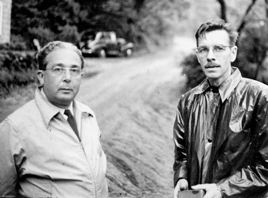1951: Genes and Mutations, Vol. XVI
Organizer: Milislav Demerec
For the 1951 Symposium, Demerec chose to revisit the theme of the first Symposium he had organized, a decade earlier. According to Demerec, between 1941 and 1951, geneticists had in some respects become "less certain than ever about the physical properties of genes". The model of genes as objects—"strung along chromosomes like beads on a thread" —"had served geneticists well in the decade preceding 1951, but now several genetic and cytogenetic studies of spontaneous and induced mutations had begun to demand that researchers rethink this model. Genes and chromosomes were both stable elements of inheritance as well as highly dynamic entities capable of undergoing (and withstanding) a great deal of change.
The 1951 Symposium featured several talks which touched on this theme. Ed Lewis elaborated on the position effect, that a gene has different effects depending on its neighboring genes. Barbara McClintock gave a further example of the dynamic genome in her talk on the Ac-Ds system in maize. It was Richard Goldschmidt who took up these issues in his remarkable opening presentation for the Symposium. Goldschmidt rejected the conclusion that a mutation at a particular point necessarily meant that there was gene there, and he offered a simile: "If the A-string on a violin is stopped an inch from the end the tone C is produced. Something has been done to a locus in the string√ČBut nobody would conclude that there is a C-body at that point." Goldschmidt suggested that in some way gene action was integrated over the whole chromosome.
On the other hand, papers by Harriet
| 
Ephrussi-Taylor and Rollin Hotchkiss did support the gene as a physical entity-they presented results in confirming Avery's transformation studies of 1944. Their audience did not seem impressed. There were other contentious topics; cytoplasmic inheritance received much attention, especially in a long paper by Sonneborn reviewing the controversial work of Fritz Moewus who had published extensively on cytoplasmic inheritance in Chlamydomonas. His work had been savaged by Philip and Haldane who showed that his results showed far less variation than would have been expected by chance. There were determined efforts to reproduce Moewus's work-including by Moewus himself under careful supervision-but with no success. Moewus is now regarded as "...one of the most ambitious cases of fraud in the history of science" (Sapp, 1989).
Demerec made an interesting comparison between the 1941 and 1951 Symposia. In 1941, 30% of papers dealt with Drosophila and only 3% with microorganisms; in 1951, 9% used Drosophila and 70% microorganisms. Five years later at the Genetic Mechanisms Symposium, none of the papers on genetic analysis used Drosophila.
— Peter Sherwood |